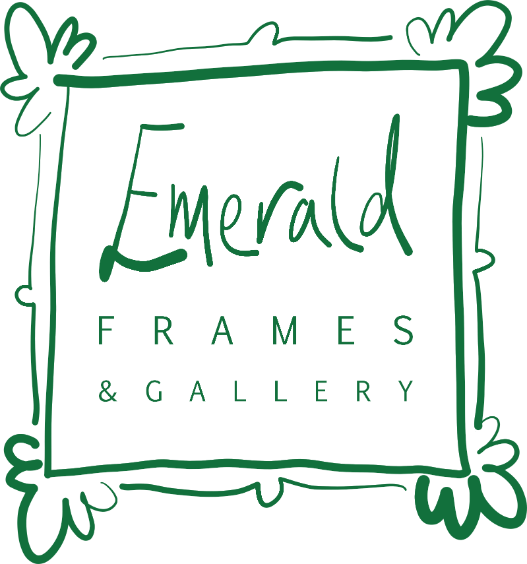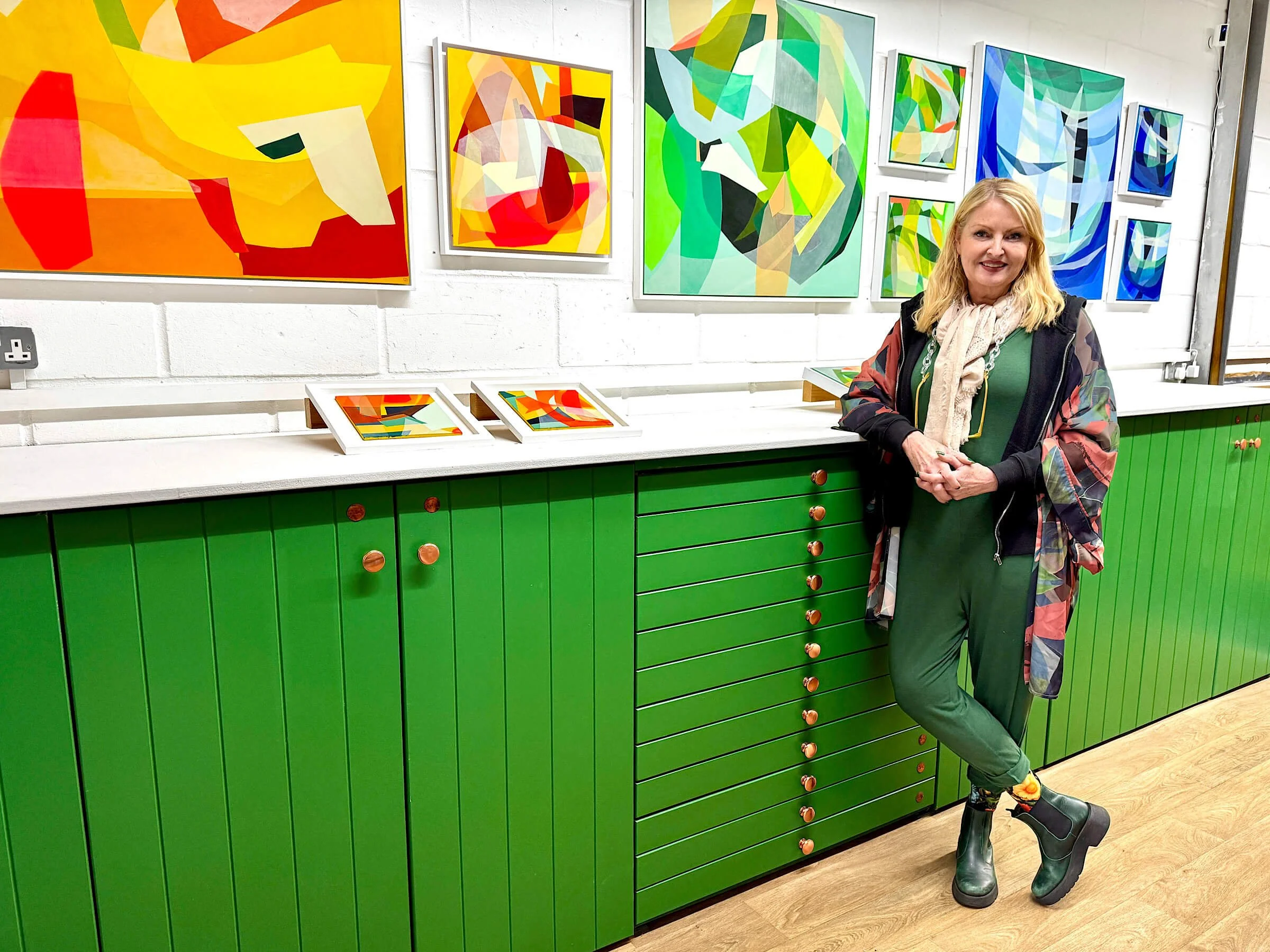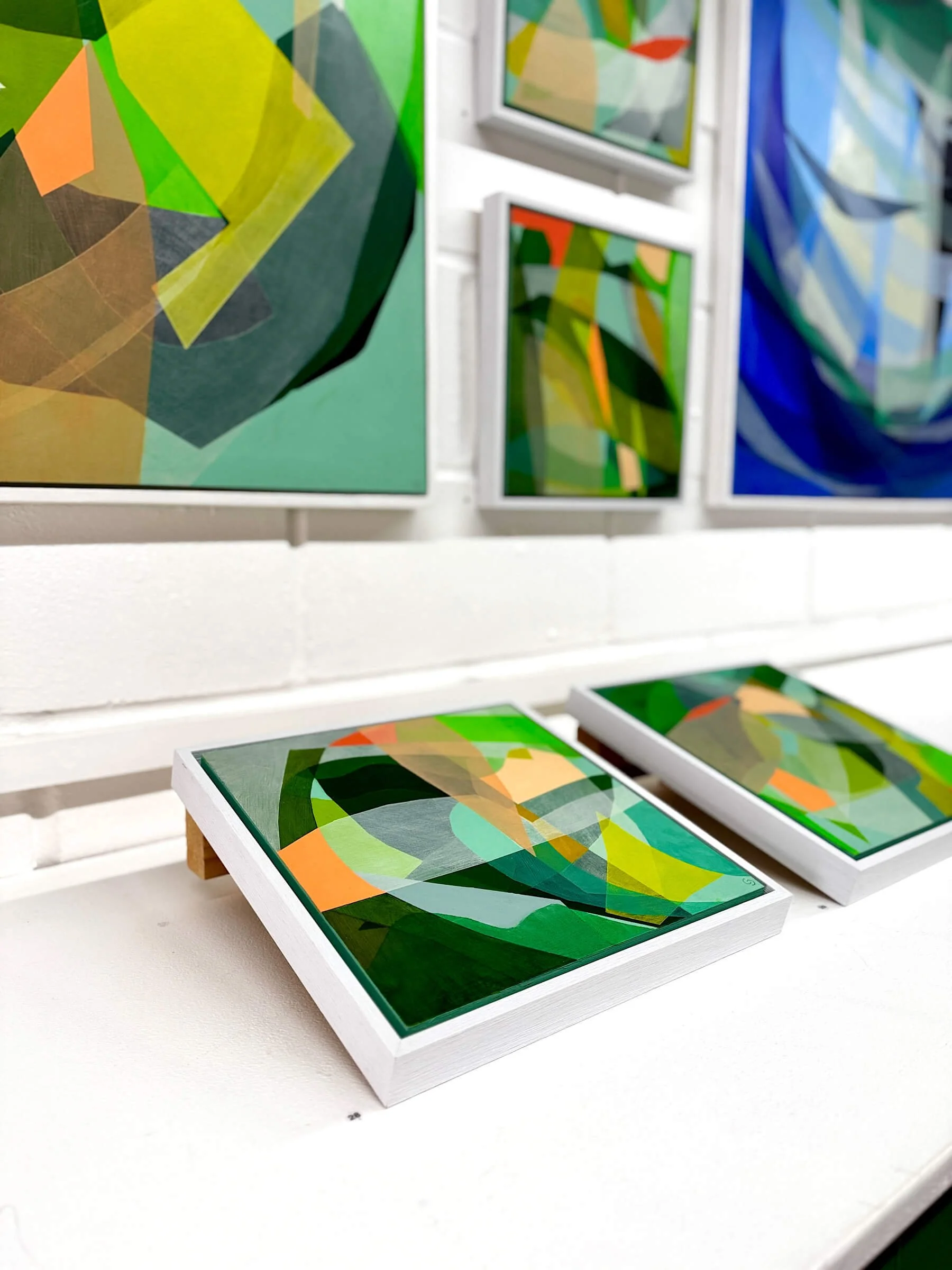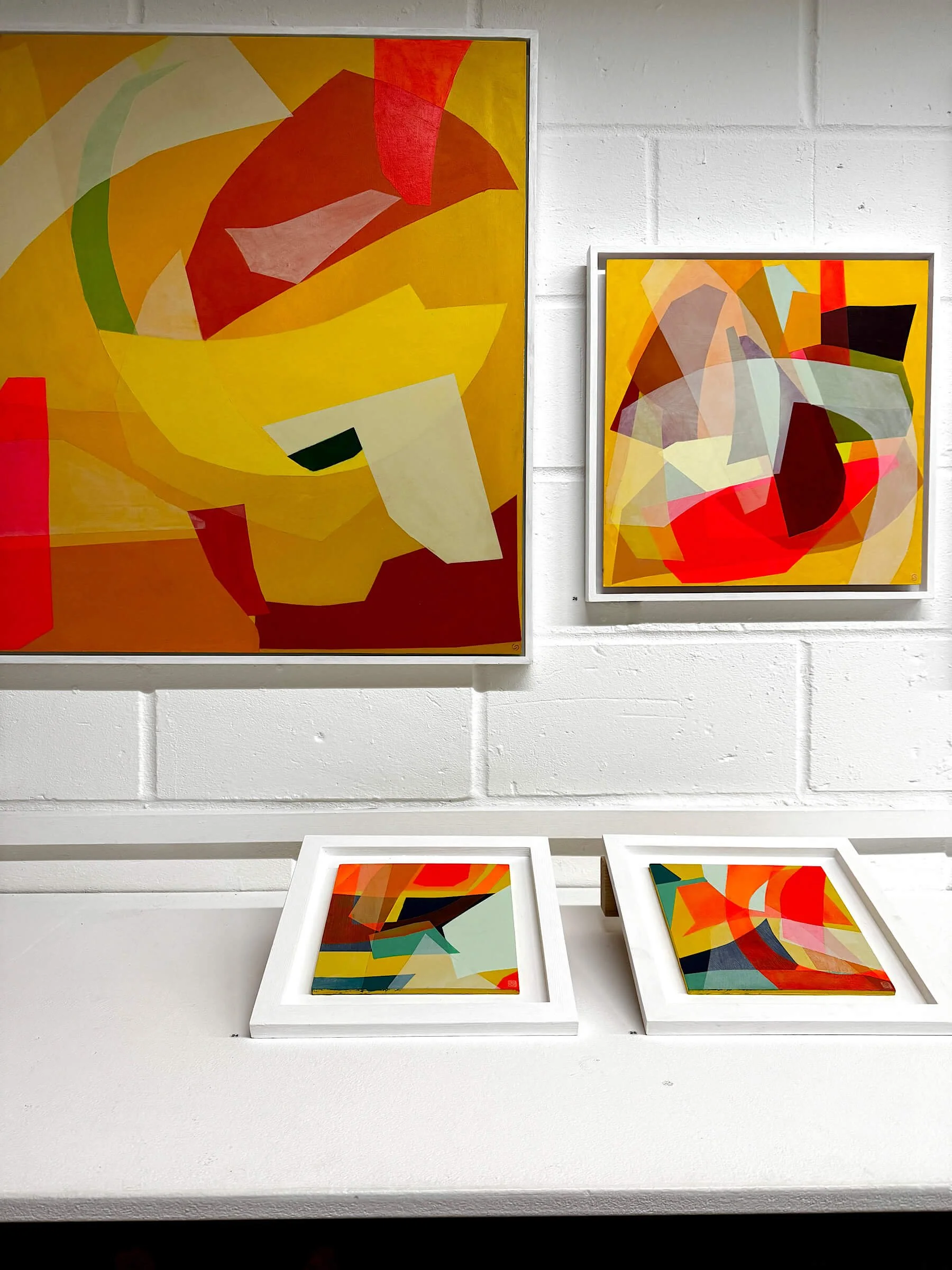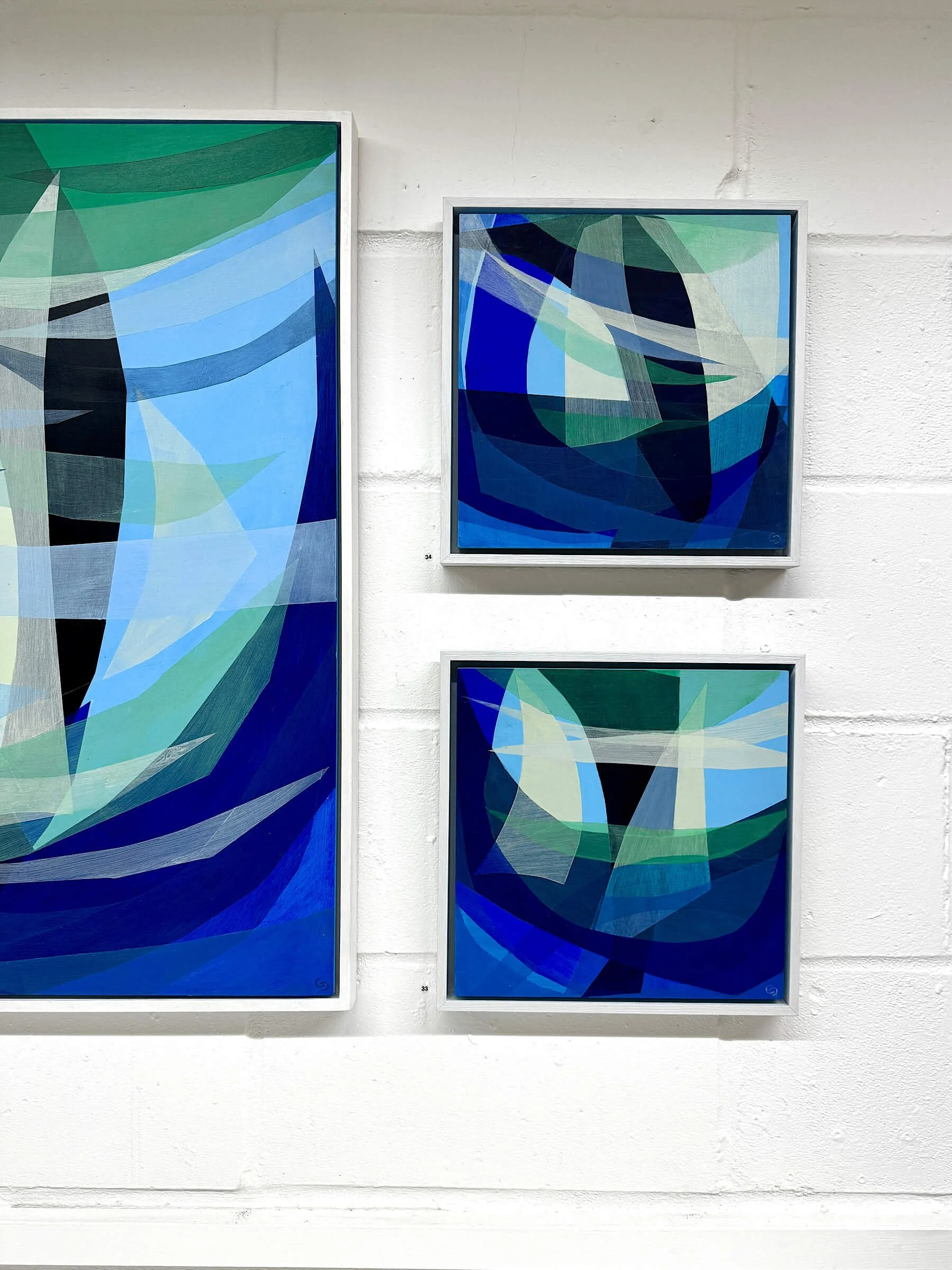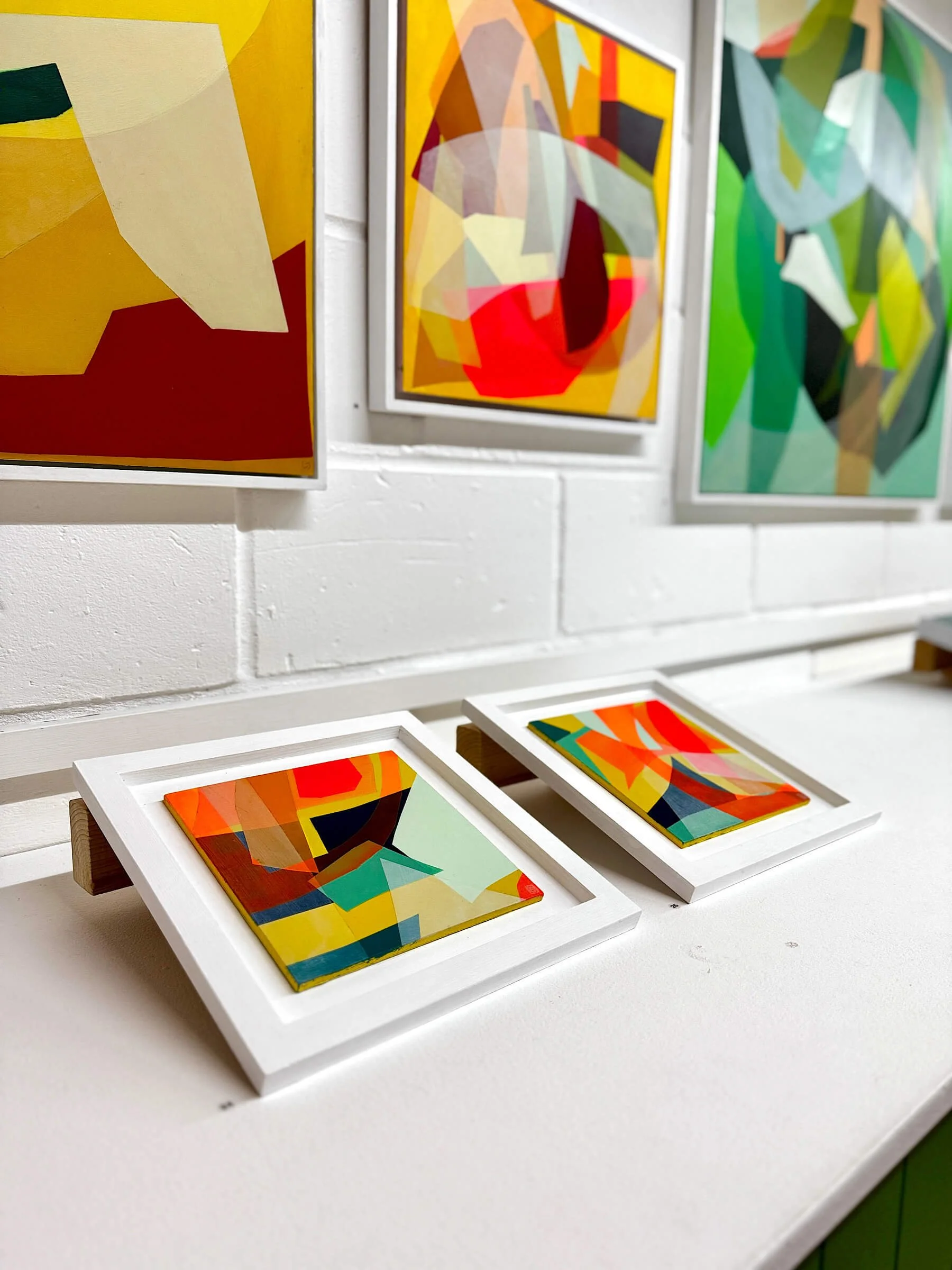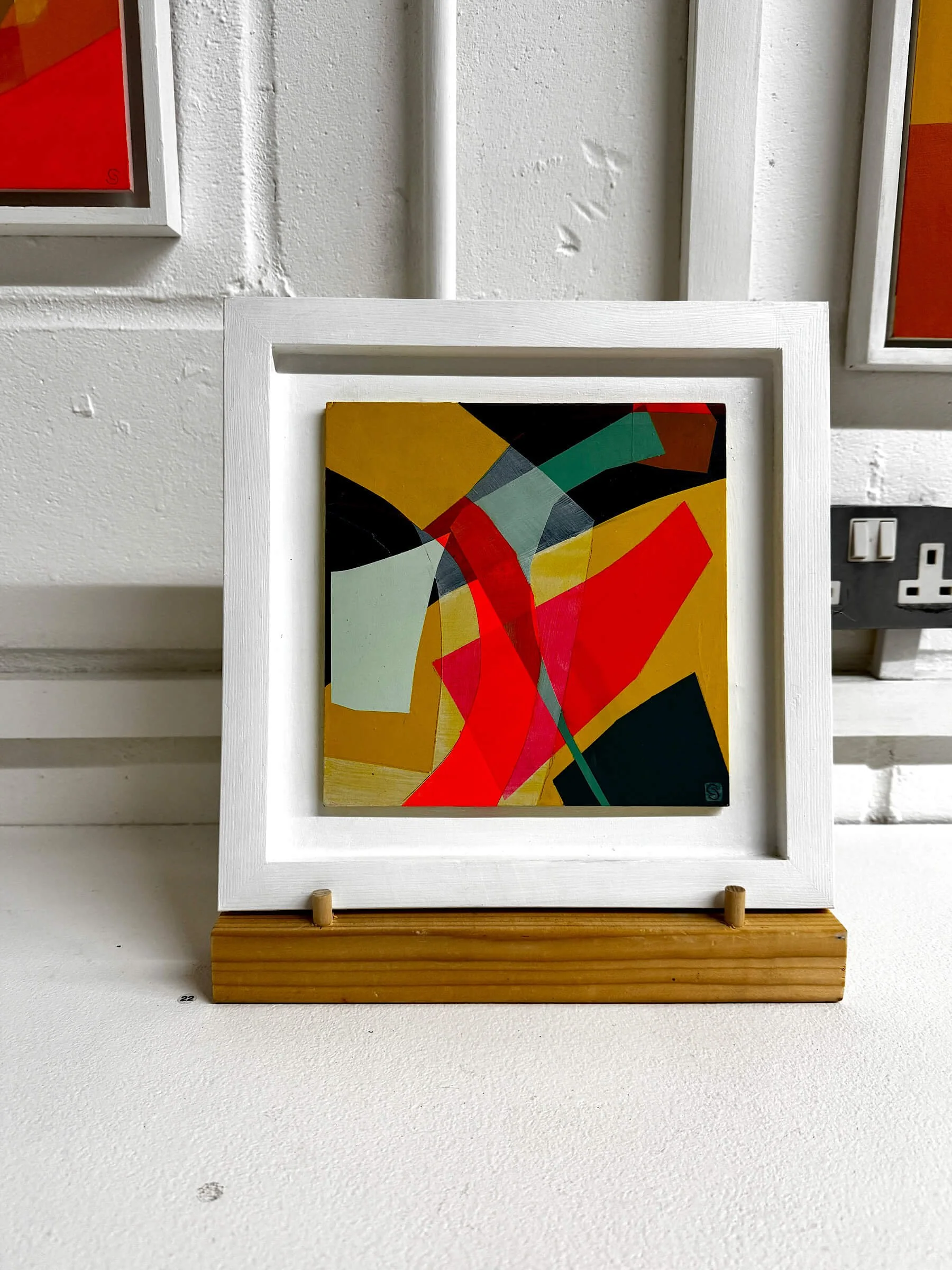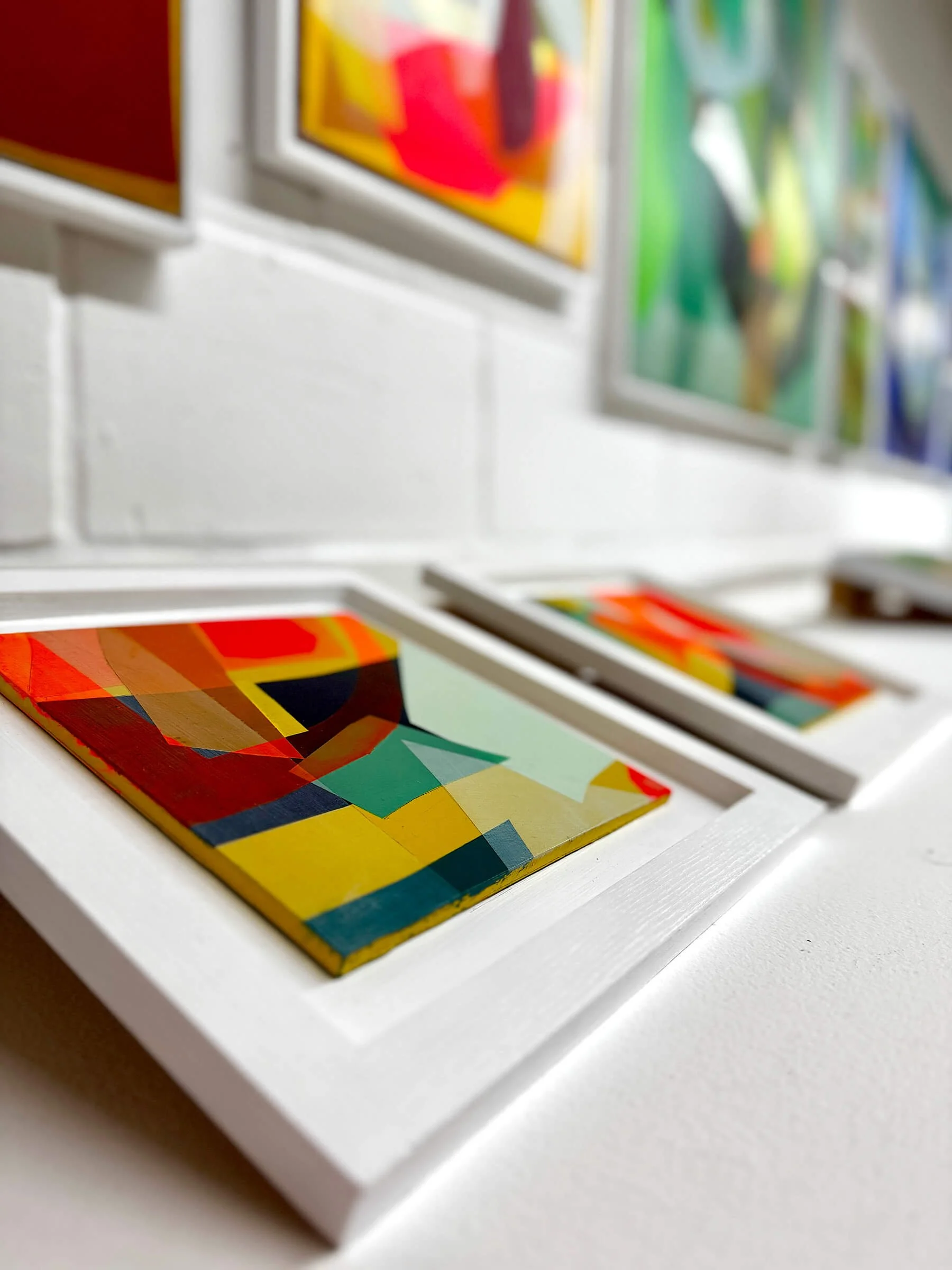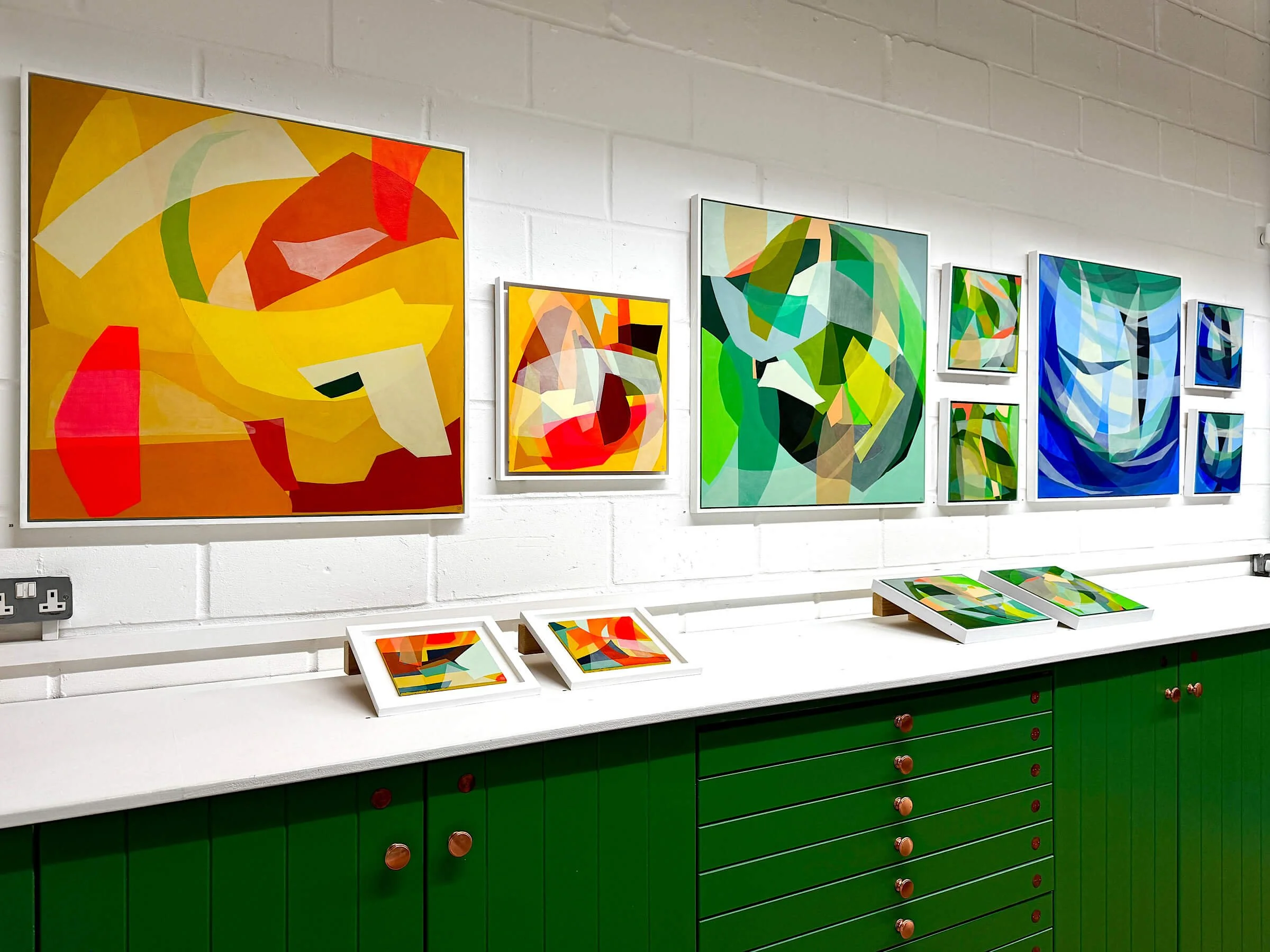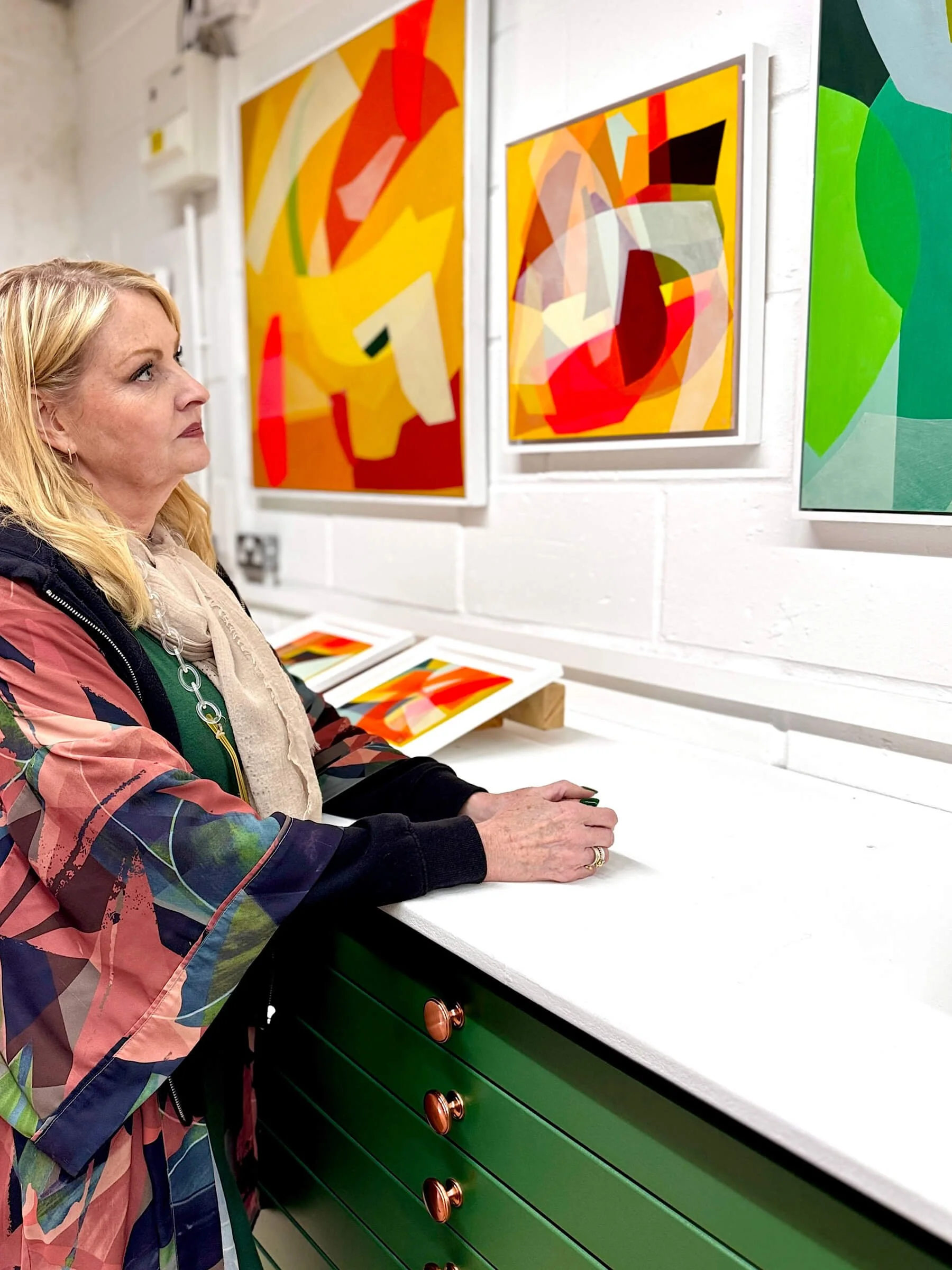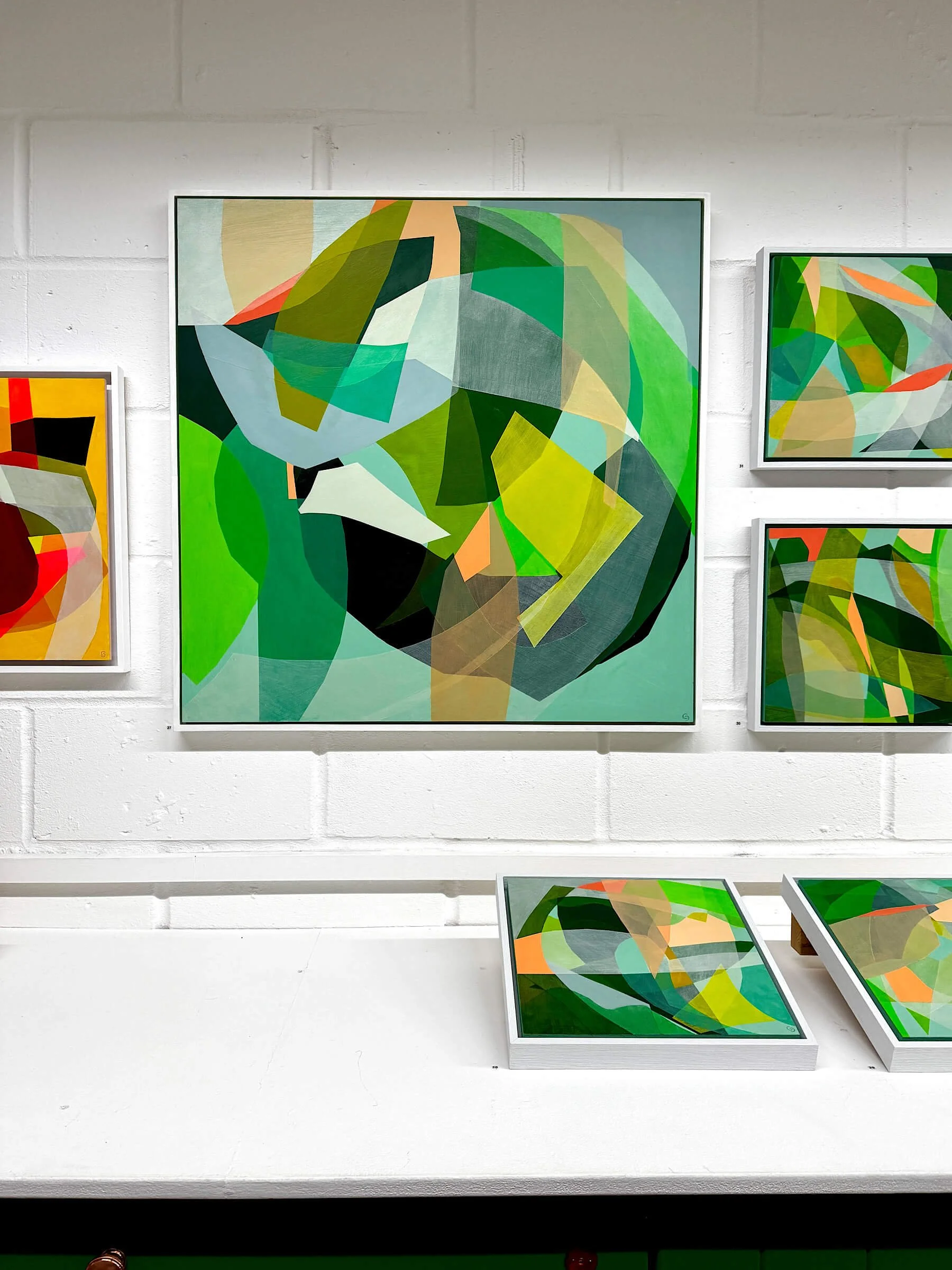In conversation with Caroline Crawford
Caroline Crawford’s paintings have a way of sticking with you — familiar, yet somehow transformed, like a memory you keep coming back to. In her new exhibition, Mango Jam, she explores that space between what we remember and what’s really there, letting colours, lines, and textures dance together to create abstract landscapes full of movement and feeling.
We sat down with Caroline to talk about the stories behind her work, her process, and how she brings these remembered places to life in her abstract paintings.
About the Artist
1. Can you share a bit about your background and what first inspired you to become an artist?
As a five year old my head teacher took a portrait I had drawn that was on the classroom wall with all of my classmates, and held an assembly all about it. I enjoyed drawing and painting and used to blend colours in my head as I went to sleep as a small child. From then I was hooked.
2. What drew you specifically to abstract painting as your primary form of expression?
Abstracts in this form is my own visual language; Abstract painting is the most challenging of all methods of painting as its entirely about creative risk. I prefer to work in this challenging way as my courses teach all other elements of drawing and painting.
3. Which artists, art movements, or cultural influences have shaped your artistic style and philosophy?
Kandinsky, William De Cooning, Barnett Newman, Ellsworth Kelly, Frank Stilla, Paul Klees shape and colour dialogues, Matisse rhythm, Van Gogh’s line and colour palette. Hard-edge geometric abstraction, is how I would describe this current collection.
About the Exhibition
4. What is the central theme or underlying concept behind this new body of work?
The paintings all have the feeling of connection and evoke the joy and celebration of place and how I absorb its beauty. The way you feel when you visit a church and view the stain glass window windows. There’s an intention of landscape painting with a back mid and full ground but not in a conventional way. The scale and pallet vary but come together like a dance or a jam. They have been compared musically to free style jazz. Mango jam, the essence of my senses, or as I describe them ‘Senssessence’ (a made-up word)
5. How did you approach curating or selecting the pieces featured in this exhibition of abstract art?
The paintings are visually powerful, and each one stands up in its own right. The curation was simple and flowing. Ali (Emerlad’s gallery manager) completely understood this and was amazing.
6. Is there a particular painting in this show that carries personal or emotional significance for you?
The title piece as it embodies the collection ‘Mango Jam’
Creative Process
7. Can you walk us through your creative process—from the first spark of an idea to the final brushstroke?
I absorb a place though every sense, let it sit, ferment and then I start to paint. Technically, I start with the ground in this case it was cadmium yellow. I then work with single coloured fluid shapes. These are painted in solid colour and I like to see what happens with the opacities of paint. Something and light some solid and heavy. Layering and creating other colours and shapes. It’s like interacting and orchestrating a painted dance between the shapes. When I paint this way, it’s more intuitive of where the piece is going. All the time I’m replaying the memories of those places and times of day the colour shapes light sound smell and taste.
8. What role does intuition or spontaneity play in your work as an abstract painter?
Lots, I let things flow, use my instincts and knowledge as a painter and take lots of creative risks.
9. Do you usually begin with a clear plan or let each piece evolve organically as you paint?
I do have an idea as more of a feeling about the work. I tend to build the paintings, make choices and decisions about colour dialogue, opacity, scale and shape. Theres a lot to consider, but I would say I let the work build, have breaks then re-evaluate.
Ideas & Inspiration
10. Where do you find your greatest sources of inspiration—daily life, nature, memories, or other art forms?
I see so much beauty in the every day. I love to be near water and landscape as it really fills my soul. I often see the world like a painting. I am constantly inspired by words, sound, and in fact all my senses
11. Are there any recurring symbols, colors, or motifs that appear throughout your work?
I like certain shapes together, and place these to build an abstract story.
12. How do your emotions or personal experiences influence the mood and movement in your paintings?
Very much, I want the energy and beauty that I absorb to spill out into the paintings.
Technique & Materials
13. What materials or painting techniques do you most enjoy experimenting with?
That’s a hard question, as I love most art materials! This series is acrylic as it works to convey, expose and reveal.
14. How do texture, color, and composition factor into your visual language as an abstract artist?
Composition is key, there is a strong flow throughout. I love contrasts to create balance in a piece. Flat and solid with light and thin, large with small, light, dark and everything in between.
Mango Jam by Caroline Crawford at Emerald Gallery.
Cultural & Social Context
15. Does your art engage with broader social, political, or cultural themes—either directly or indirectly?
They are an absolute escape from the current horrors of the world. I like to take a trip away for a bit with them.
16. What kind of dialogue or emotional connection do you hope your paintings inspire in viewers?
The paintings all have the feeling of connection and evoke the joy and celebration of place and how we absorb its beauty. The way you feel when you visit a church and view the stain glass windows. I want each viewer to be able to use their senses to explore my work.
Audience & Interpretation
17. What’s the most unexpected or memorable reaction someone has had to your work?
I think the moment that a painting touches, lands or hits a viewer emotionally, they understand it and feel its beauty. Then I feel connected with them, like they understand my visual language.
18. Do you prefer audiences to uncover your intended meanings, or to interpret the work in their own personal way?
I like to give a bit of a narrative, but usually the people that like my work like abstracts. I want the kind of engagement with the painting that takes effort from the viewer.
Looking Forward
19. After this exhibition, what’s next for you creatively?
I will start more work; I have some ideas in mind. I paint with my students every week on my Caroline Crawford painting courses and workshops.
20. Are there new themes, materials, or directions you’re excited to explore in your future practice?
Yes, I grew up in mid psychedelia in a house designed by my architect father. Beautiful straight gliding shapes and lines that even then at three years old were pleasing to the eye. I love the beauty and playfulness of mid-century art and design. Its very apparent in my work, and I want to explore this further. I always have lots of ideas buzzing around!
Mango Jam by Caroline Crawford. Open Tuesday to Saturday from 9 to 5. 18th October to 15th of November. Come and visit!!
